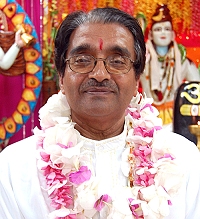From a satsang with Paramacharya of SWAHA, H. H. Pt. Hardeo Persad
Bhagavan Shree Krishna manifested in the age of Dwaapar, about 5,000 years ago. His last message to humanity was documented in the Uddhava Gita. In the discussion, He answers many of the questions posed by His devotee, Uddhava.
On the issue of types of moral restraint and positive virtues, Shree Krishna explains that the forms of yam or moral restraints are non-injury, non-aggression, truthfulness, honesty, non-attachment, shame, non-accumulation of wealth, faith in God, chastity, silence, patience, forgiveness, fearlessness; the forms of niyam or positive virtues are purity of mind and body, repetition of the Lord’s name, austerity, offering oblations in the sacred fire, faith in one’s self, hospitality, worship of the Divine, visiting of holy places, working for the good of others, contentment and service unto the Guru.
Those groups of virtues, if properly practised by devotees, will surely produce results according to their desires, that is, liberation. In response to Uddhava’s questions, He also explains what some of the main principles and qualities mean:
Dharma (religion, righteous conduct) is the wealth that humans should covet.
I, the Supreme Lord, am the ultimate sacrifice.
The imparting of knowledge is religious remuneration.
The highest strength is the control of praana, the lifeforce, through praanayam (control of the breath).
Fortune is My divine state.
The best profit is devotion to Me. Where there is bhakti (devotion), there are the other forms of wealth: arth (material wealth), dharma (righteous conduct), kaam (legitimate pleasure) and moksha (liberation).
Learning is the destruction of the idea of multiplicity of the self. The scriptures teach us that the ultimate state of existence is non-duality, Aham Brahmasmi. The cause of multiplicity is maayaa (the Lord’s delusive power).
Shyness is the abhorrence of evil actions.
Beauty consists of virtues, such as the spirit of independence.
Happiness is the transcending of pleasure and pain, as this brings about equanimity of mind. Such happiness is not transitory and impermanent as that based on the things of the world.
Misery is the hankering after sense pleasures. Giving gow daan, the charity of a cow, for example, is symbolic of giving up the senses to a holy man who has the spiritual wherewithal to assist us to control the senses.
A scholar can distinguish between bondage and liberation.
A fool identifies himself with the body.
The right pathway is the one that leads to Him, Shree Krishna.
The wrong way is that which causes disturbance of the mind. Seeking material prosperity at the expense of spirituality is the wrong way.
Heaven is the rise of sattva (the mode of piety and purity) in the mind.
Hell is the rise of tamas (lethargy, dullness) in the mind.
The teacher who is Myself, Bhagavan Shree Krishna, is the friend.
The human body is the home. Inner cleansing of negative qualities is even more important than cleaning the external surroundings.
The rich man is he who is rich in virtues. The poor man is he who is discontented.
He who is not a master of his senses is mean.
One who is not attached to sense objects is lordly, a king. One who is attached to sense objects is the reverse.
In order to advance spiritually in life, we must develop these positive virtues and practise moral restraint daily.



